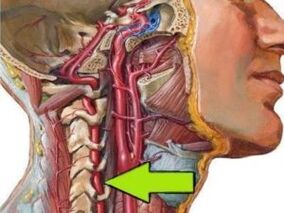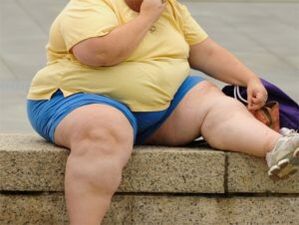Among all the pathological processes that affect the spine in its different parts, cervical osteochondosis is considered one of the most common and painful.This disease leads to numerous complications, mainly because it affects the spinal cord, and also negatively affects the functioning of the brain.

What is cervical osteochondosis?
The words of cervical osteochondrosis in medical practice mean a gradual acquired disease which affects the specific spine.This pathological process is characterized by dystrophic degenerative processes in the tissues of intervertebral discs, which are shock absorbers for cervical vertebrae.Degenerative-dystrophic changes in intervertebral discs are due to the fact that they are erased and deformed.Consequently, the distance between the vertebrae is reduced and, therefore, the following consequences occur:
- Rachio channel narrowing in certain areas of the spine.
- Pass the vertebral arteries - large blood vessels that supply blood supply to the brain.Because of which the brain supply worsens and blood circulation in the cervical spinal cord is disturbed.
- Intervertebral discs can be deformed and flattened.This leads to the compression of individual sections of the spinal cord and nerves, more often, the nerve roots are pressed.
All these problems threaten not only a violation of the blood circulation of the brain, painful sensations in the neck, headaches, etc.The development of osteochondrosis in the cervical region is dangerous with problems of neurological nature, the worsening of the central nervous system, damage to brain tissues.According to the international classification of diseases, several distinct codes have been assigned osteochondrosis of the cervical region.The disease code for ICB 10 depends on the age of the disease: the disease has been diagnosed:

- M02 - Dystrophy of intervertebral discs in adolescence.
- M42.12 is a dystrophic process in the neck in adults.
Many factors depend on the age of the patient and the degree of development of the pathological process, for example, the consequences, complications, symptoms and, of course, the principles of treatment.
Causes
Knowing the causes of the development of osteochondrosis in the cervical region can play a decisive role in the diagnostic process, as well as the determination of the principles of combating disease.However, before listing the reasons, it should be said that doctors distinguish two factors that lead to the development of this pathological process:
- Pathological - The destruction of intervertebral discs and other vertebrates with the involvement of tissues, blood vessels and nearby nervous beams in the pathological process under the influence of unfavorable external factors.The more difficult these factors and other pathologies, the more the disease develops.
- Physiological - based on the development of pathology, mainly age -related changes.We are talking about the natural aging of the cartilaginous tissues in the spine, salts, etc.
If we list more specific causes of cervical osteochondosis, they are as follows:
- Violation of metabolic processes in the body, as well as certain stages of obesity.
- Hypodynamia is a phenomenon characterized by a limitation of mobility.These are not only injuries or diseases, this can also include a sedentary lifestyle and sitting work.
- Pathologies of the cardiovascular system, contributing to alteration of blood circulation in the brain, pressure changes and other things.
- Incorrect posture, these are various forms of scoliosis, rheumatism and even flat feet.
- Injection of the cervical column.In this case, we are talking about cakes, strikes, bruises.Investigations on other green columns in the development of cervical osteochondosis can influence the development of cervical osteochondosis.
- Excessively significant physical effort on the cervical region caused by intensive sports or a great physical difficulty, depending on the type of human activity.
- A sedentary lifestyle is also dangerous with constant tension of the cervical column and the whole spine, if you are wrongly sitting or uncomfortable furniture.
- A hernia of the cervical column, as well as various related diseases.
- Long -term forced head of the head in an uncomfortable or unnatural position.In this case, not only does the muscular occurrence occur, but the spine is also bent in the cervical region.
- Doctors consider constant stress and nervous overvoltage as a very common cause.
- One of the reasons is also considered as congenital anomalies in the structure of the spine.

What is the danger to health?
As mentioned above, in the cervical column, not only the spinal cord and various nerve branches are located, but also the vertebral arteries which provide the occipital part of the brain, the cerebellum and the medullavic brain.With the development of cervical osteochondrosis, neighboring tissues are ignited.In addition, the development of pathology threatens to tighten the nerve roots and transmit blood vessels, the consequences are as follows:
- Osteochondrosis is accompanied by deformations of the spine, a consequence of which the cerebrospinal channel is narrowed in certain areas.This can lead to the pressing of the spinal cord and nerve branches, which promises serious neurological problems.In serious cases, a person feels pain, even there is a possibility of loss of control over individual parts of the body (mainly in the hand or the face).
- The compression of the vessels of the neck, as already mentioned, is accompanied by a violation of the blood circulation in the occipital region of the brain.At the same time, the brain ceases to receive oxygen and nutrients in the required quantities, the famine of oxygen begins.With circulatory disorders, there is a real risk of ischemic stroke and various neurological pathologies.
Syndromes
Main syndromes are:
- Vertebral.
- Vertebral artery.
- Koreshka.
- Heart.
It is important to know that each of these symptoms is accompanied by painful sensations of a different nature, as well as many unfavorable clinical signs.A person can feel dizziness, a noise appears in their ears and much more.

Vertebral syndrome
He talks about the direct connection of osteochondrosis in the cervical region with bone and cartilaginous tissues.Symptoms of this type of pathology are also associated with the fabric lesion mentioned:
- The movements of the neck are partially or completely limited.
- The movements of the head are accompanied by pain in the neck.
- X-Ray shows morphological changes in the tissues (intervertebral and in the body of the vertebrae).
It should be noted that vertebral syndrome is always accompanied by these three clinical signs.If at least 1 of them is absent, the diagnosis will be completely different.
Rook syndrome
It occurs when the spinal cord roots are damaged.At the same time, nervous conductivity is disturbed, a person may feel pain or lose the sensitivity of the individual parts of the body or even suffer from paralysis.According to which 8 radicular couples, there is a disturbance of conductivity, such symptoms are distinguished:
- 1 pair - numbness or pain at the back of the head;
- 3 pairs - violation of the chewing reflex, numbness of the tongue and unpleasant sensations behind the ears;
- 4 pairs - pain in the collarbone, violation of the swallowing reflex;
- 5 pairs - violations of the shoulder belt, accompanied by the problem of hand movement;
- 6 pairs - The patient begins to feel pain and numbness in the forearm and the shoulder blades;
- 7 pairs - Hands and fingers become numb (often index and middle);
- 8 pairs - Problems similar to the past element, but numbness is felt in the annular and the little finger.
Cardial syndrome
Despite the fact that the pathological process is still located in the cervical column, syndrome has all signs of cardiac pathologies.The clinical image is as follows:
- Quick pulse.
- Pain in the sternum region.
- Shortness of breath, weakness, lethargy, reduction in performance.
Signs and symptoms of cervical osteochondosis
For a timely research of a doctor, it is necessary to clearly understand the signs of cervical osteochondosis.In some cases, such knowledge allows you to ask for help at the early stages of the disease, when it is easier to treat.In general, the symptoms of osteochondrosis of the cervical column are as follows:

- Pain for osteochondrosis is always present, only intensity and frequency differ.It is a pain that is the first clinical sign.Their intensity depends on the stage of the progression of the disease, in the wild, they are stupid or in a hurry.Painful sensations are mainly present in the neck of the occipital region, but can also radiate towards the time region, the shoulder belt and the hands.
- In most cases, there are manifestations of the lesion of the vestibular apparatus.We are talking about frequent vertigo without cause, nausea, altered coordination of movements, unequal approach, loss in space.
- One of the most common clinical signs is the rigidity of the neck muscles and the stiffness of the movements.It is difficult for a person to turn around, lower and throw their heads, the movements respond with episodes of pain.
- Many patients note the feeling that goosebumps "crosses the scalp" or characteristic tingling is felt.
- In the hands area, there is muscle weakness and numbness.
- Often there are psychological manifestations, expressed in depression, drowsiness, a clear change in mood, temperament or irritability.
- Due to altered blood circulation and damage to cerebral tissues, dizziness intensifies and noise in the ears appears, similar to rustling, pulse, ringtone.
- Most patients note a visual impairment, as well as pain in the eyeballs, especially when you try to considerably mow your eyes to the left, right, upward or down.
It is sometimes possible to determine the degree of development of the pathological process by symptoms.However, for a complete diagnosis of this, this is not enough and a number of diagnostic measures are necessary.
Diagnostic methods
A diagnosis of osteochondrosis of the cervical column is necessary to determine the location and the stage of progression of the disease.For the complete diagnosis, such diagnostic methods are necessary:
- X -Ray - The main method which allows you to determine the degree and the location of the deformation of the spine.
- You can use computed tomography for a more precise diagnosis of pathological changes in vertebrae and intervertebral discs.
- MRI (Magnetic imagery) - allows you to examine in detail the wheels and vertebrae, determine the presence of hernias, protuberances and the lesions scale of the rest.
- Doplerography - At the same time, the examination becomes the possibility of finding a place to press the artery, assess the degree of circulatory disorders.
Treatment methods
The treatment of neck osteochondosis always involves an integrated approach.The principles of treatment depend on the mass of factors, such as the age of the patient, the stage of development of the disease, the brightness of the clinical image, etc.However, you cannot do without a doctor in this situation and first you can consult a therapist who will then head to a vertebrologist.As for the integrated approach: osteochondrosis of cervical osteochondosis is treated using drug treatment, physiotherapy, massages, exercise and other methods that should be discussed in more detail.
Drugs
The basis of treatment of cervical osteochondosis is drug treatment, which implies the use of tablets, drugs and drugs from these groups:
- Anesthetics - pain relievers and antispasmodic.The first nerve centers directly dull, thus stopping painful sensations.These allow you to relieve spasms of the neck muscles, establish the blood flow and remove the pain.
- Ainsa - Non -steroidal anti -inflammatory drugs are necessary to reduce the inflammatory process, most also eliminate pain.Often these drugs are used in the form of gels, ointments that are rubbed in the affected area.
- Musorelaxing is another way to eliminate muscle spasms in the cervical region.
- Chondroprotectors are compulsory at certain stages of hop osteochondrosis because they contribute to the restoration of bone tissue.
- B Vitamins - normalize the metabolic processes of nervous tissues, improve the conductivity of nerve impulses and contribute to the work of the central nervous system.
Remember that the treatment should only be carried out under the supervision of a doctor, who is responsible for the appointment of each medication, as well as to determine the duration of his contribution and his dosage.
Physiotherapy
The treatment of neck osteochondrosis will be much more effective using certain physiotherapy techniques:

- Electrophoresis.
- Laser therapy.
- Ultrasound.
- Massage.
Massage therapy is necessarily carried out by an experienced health worker, the treatment is carried out by at least 10 sessions.Massages in the cervical region help normalize blood circulation, restore elasticity, muscle tone, relieve pain, etc.
Manual therapy
Manual therapy is based on the principle of restoration of motor functions and mobility between the vertebrae.Initially, the manipulations are in a slight relaxing massage, then the doctor attaches more and more force, acts on the vertebrae of the pressure and the towers of the neck.
The use of Kuznetsov applicators is one of the therapy methods for spine diseases, including osteochondrosis.The effect of adaptation on the cervical region normalizes metabolic processes, relieves pain, increases muscle tone, improves blood circulation, increases the conductivity of nervous tissues, etc.


























































































